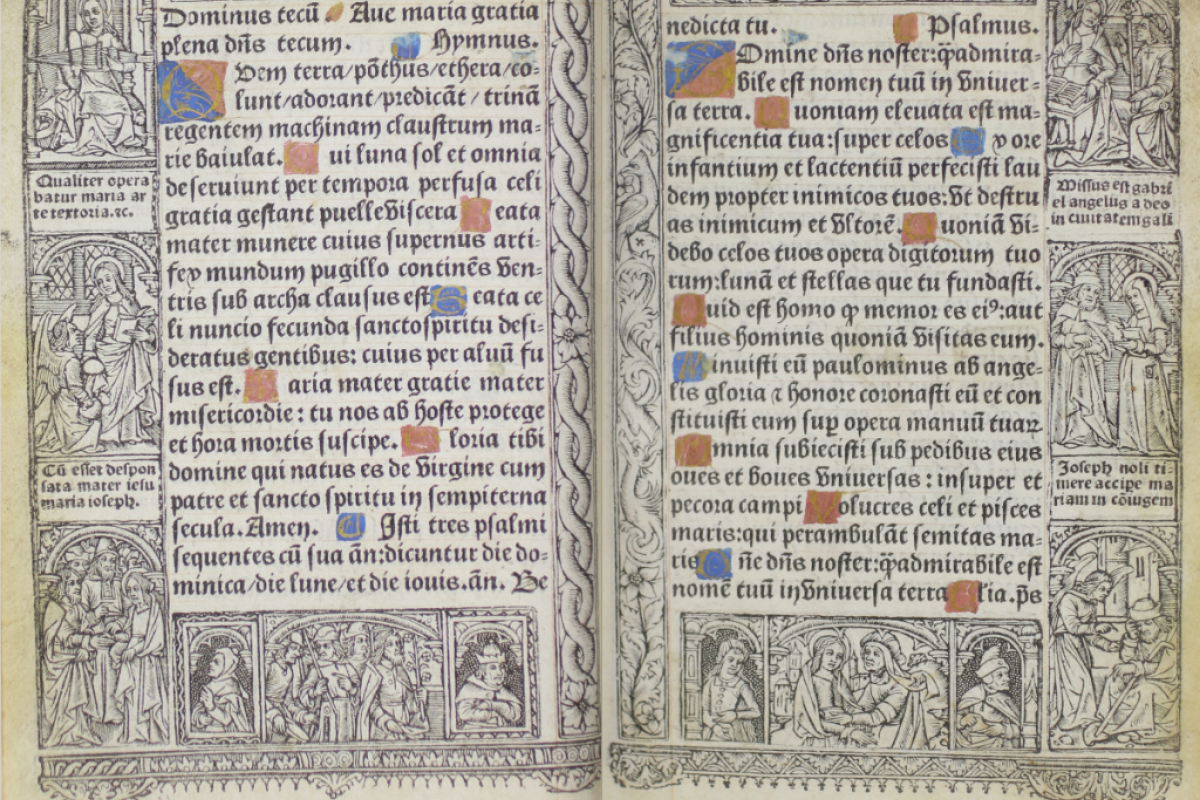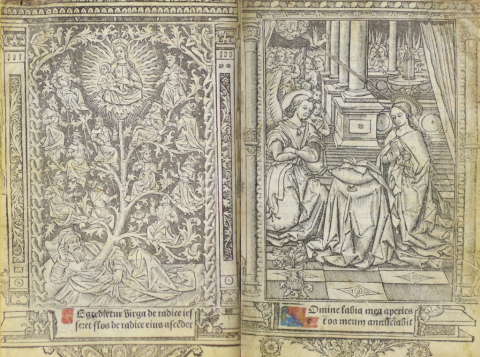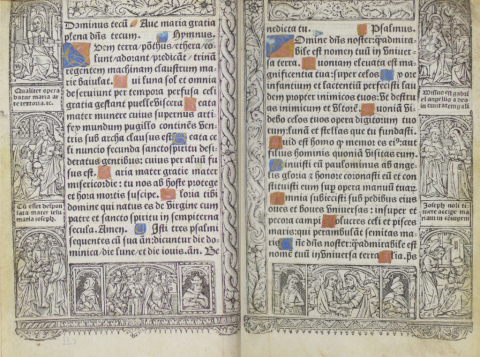Book of Hours, Use of Langres
Book of Hours, Use of Langres
French (Paris), ca. 1502
Language: Latin, French
vellum
height 15.8 cm
width 10.3 cm
142 leaves. Bâtard type-face. 21/22 lines. Gatherings mostly of 8. Text in Latin and French: Calendar, Gospel Lessons, Passion of Christ, Hours of the Virgin, of the Cross, of the Holy Spirit, Psalms, Litany, Office of the Dead, Various Prayers, Obsecro te, O Imtemerata, Prayers to Saints. 17 metal or woodcuts, printed panel border designs, capitals painted in gold, red, and blue. Binding: brown pigskin. Slip cased. Fols. e1v-e2r. Text pages
Publisher/Printer: probably Philippe Pigouchet for Simon Vostre
Provenance: Curt and Lilli Sobernheim (ex libris); Melville Eastham, Cambridge.
Willamette University, Mark O. Hatfield Library Special Collections: BX2080.P5 1502
Diebold, William. The Illustrated Book in the Age of Printing: Books and Manuscripts from Oregon Collections. Portland, OR: Douglas F. Cooley Memorial Art Gallery, 1993, pp. 12-13 - Quoted with permission
Although the program of decoration in printed Books of Hours tended to follow traditions already established by manuscripts, the printed Books are remarkable for the number of illustrations they contain. Every page in number 29 [refers to exhibit from which this text was a catalog entry], for example, has fully illustrated borders. The reproductive nature of printing meant that, once wood blocks had been cut and were owned by a printer or publisher, they could be used again and again with no additional cost. Thus, many of die same blocks are used in both numbers 29 and number 30, even though the actual text of the pages on display differs. No manuscript Book of Hours, no matter how sumptuous, had this wealth of decoration. Printing raised the stakes of how densely a book could be illustrated; manuscript makers tried hard to respond. Number 12, a manuscript contemporary with these printed Books of Hours, has an exceptionally lavish program of illustrations, even though there is no sign that it was made for a particularly elevated patron. Rather, the large number of miniatures is probably an attempt to compete with the proliferation of images brought about by printing. In the page on display the unusual two-tier format, with the scene of David killing Goliath in the lower register, may have been inspired by the small scenes which fill the margins of printed books of hours such as numbers 29 and 30.
Parshall, Peter. Illuminated Manuscripts from Portland Area Collections. Portland, OR: Portland Art Museum, 1978, p. 46 - Quoted with permission
Although the title page is missing, it seems likely that this Book of Hours is one of many printed by Philippe Pigouchet for the Paris Publisher Simon Vostre. Its manufacture and format, including an extensive cycle of illustrations and many panels of border decoration, are features designed in imitation of illuminated manuscripts. In fact, this book is even printed on vellum despite the fact that paper has been usual for printed books from the beginning. This considerably enhances its value. Illustrations in printed Hours were often colored by an illuminator as well, though only capital letters are rubricated here. The border panels were designed as movable strips such that they could be pieced together in various combinations surrounding the type matrix and reused throughout the texts. Luxurious printed hours attest to the sophistication of early printing technology as it developed in direct competition with hand-made and illuminated manuscripts. This brief phase of parallel development resulted in many fertile interchanges between the two media. The printed Willamette Hours, like the handcrafted and decorated French manuscripts of the period, shows the influence of Italian style. Furthermore, the border designs include a variety of religious and secular motifs, the latter taken from a repertoire of courtly decoration. The rise of printing was the essential factor that brought the history of manuscript illumination to a close. No doubt for economic reasons the manuscript had become a luxury and soon fell out of fashion.






